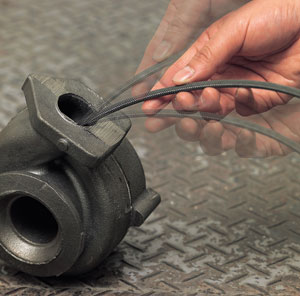
[Backgrounds]
In the automobile industry, fuel efficiency is increasingly improved with the spread of eco cars such as EVs and hybrid vehicles, and fossil fuel engines have smaller displacements and are becoming smaller. In the meantime, it is necessary to maintain the vehicle's power, and therefore, the turbo technology, which spread widely in the 1980s to 1990s, is now drawing attention again in order to respond to the conflicting demand for achieving both high fuel efficiency and high power. European automobile manufacturers are producing more small-sized fuel efficient cars with 1,000 to 1,500 cc engines added with turbochargers, and great importance is attached to quality control and inspection of turbochargers.
[Problems]
The turbocharger contains a rotary turbine in order to increase the pressure during charge using the kinetic energy of the exhaust gas. In addition, it has a structure in which the air passage is narrowed down in stages to increase the pressure, and has a complex, snail-like shape. Therefore, the turbine casing is a cast component.
For cast components, it is important to check whether the melted material has reached every part of the sand mold to form a proper shape. The sand mold must be completely removed, and any part in contact with another component needs to be machined. In doing so, problems such as the following may occur.
- Since the temperature of the melted material will be as high as 1,000°C, the mold may be sand-burned to prevent the material from being cleanly released from the mold.
- When the material is poured into the mold, air may be caught to produce a cavity.
- Sand in an elaborately structured part may not be completely removed and clog the part.
- When the melted material at high temperature is cooled and solidified, a crack or a shrinkage cavity may be produced.
- Burr or chips may fall into the component and remain there.
In many cases, these problems occur in deep places that cannot be directly peered at, and tend to be overlooked. In addition, it is also necessary to check whether or not any displacement has occurred after each component is installed. Therefore, internal inspection with an industrial endoscope, which is the quickest and most reliable quality inspection method, is conducted. With the endoscope, mainly the inside of the snail-shaped part is inspected, and the clearance between the installed turbine and the turbocharger casing is checked.
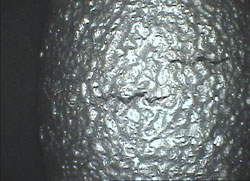 | 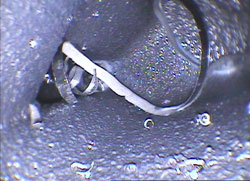 |
| [Images of cracks and chips inside the cast component photographed using an Olympus videoscope] | |
[Benefits specific to Olympus]
Olympus' industrial endoscopes used most frequently for internal inspection of turbochargers include flexible types, which have a diameter of 2.4 to 6.0 mm and a length of 2 m, and the following various characteristics suitable for inspections.
- Dust-proof and drip-proof performance: Each of these industrial endoscopes has dust-proof and drip-proof performance enabling it to be used even in an atmosphere containing dust generated in a foundry and cutting oil for machining.
- Various optical adapters: For each flexible-type scope, a lineup of optical adapters that can be selected from according to various inspection applications are available.
- A highly durable insertion tube: A tungsten braid is adopted in the flexible-type scopes, while stainless steel is adopted in the rigid type. For both types, materials capable of withstanding frequent insertion for inspection are used.
- A tip-bending mechanism that enables the user to easily observe the target point: In the flexible-type scope, the scope tip can be appropriately manipulated through hand operation.
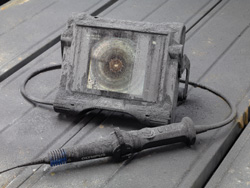 [Dust-proof performance of IPLEX TX] | 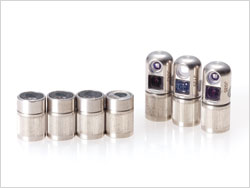 [Various optical adapters for IPLEX RX] |
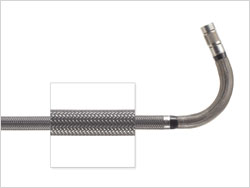 [A high-density tungsten braid of IPLEX RX] | 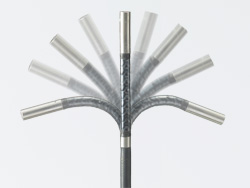 [A tip-bending mechanism of IPLEX TX] |
Thanks to these excellent performances, Olympus' industrial endoscopes are adopted in the sites of quality inspection of turbochargers at automobile manufacturers and automobile component manufacturers around the world.
For more information, contact your local Olympus representative.

